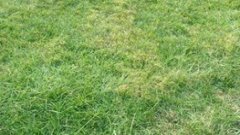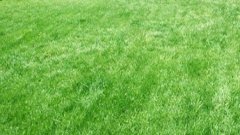OVERSEEDING & SOD
The concept of overseeding lawns as part of a regular maintenance has been around for years, but it is still new to many homeowners. This one step will do more to improve the quality of your lawn than almost anything else you can do.
For the organic and conventional home turf experts, this is one of the best things you can do. Years of experience proves this. The information on this page will explain why overseeding your lawn is so important for a thick, healthy, and weed free lawn.
The two images below show the same fescue lawn before and after seeding. Overseeding was performed in early fall and was recommended due to thinning grass and increasing weed problems. The second image was taken the following spring after overseeding. The grass is thicker and the thin areas have filled in.

BEFORE SEEDING

AFTER SEEDING
Grasses that Benefit From Overseeding
The practice of overseeding lawns is really nothing more than spreading grass seed over an existing lawn. The golf industry has been doing it since the sport began and is an important step in maintaining quality turf. Knowing how to do it correctly is the key.
Not every grass type requires overseeding. The practice of overseeding lawns is primarily reserved for cool season bunch type grasses such as tall fescue, fine fescue, perennial and annual ryegrass and occasionally bluegrass. There are exceptions, but for most home lawns, grass types that spread by the production of “runners” are not generally overseeded unless it is damaged or diseased. This includes most warm season grass varieties. An exception is bermudagrass that is occasionally overseeded in the fall using a cool season variety.
Understanding Grass Growth
Most cool season grasses are bunch type grasses. As the name sounds, they grow in a bunch, but growth habits are largely misunderstood. When lawn grass seed germinates, a single grass blade emerges. The grass crown, at the plant’s center, have roots growing down from the crown and the blades growing up. Grass plants expand as new grass blades, called tillers, develop and grow along side the original crown. Hundreds of new tillers can develop, each having its own crown, roots and blades. A blade of grass has a short lifespan of about 6 weeks and must continually produce new tillers or the grass thins out. If you would like a better understanding of how grasses grow, see the page on Photosynthesis.
Why is Overseeding lawns Necessary?
After several years, mature plants begin to slow down their reproduction rate. Since a blade of grass lives only an average of 45 to 60 days, production of new tillers must continually outpace the dieback of older leaves. Young grass will produce tillers faster than older grass. Therefore, one of the most important secrets to maintaining a healthy, thick lawn is to make sure your grass is young. (Nick Christians, PhD, Iowa State University) The practice of overseeding lawns is the easiest way of Keeping grass young.
When is the Right Time for Overseeding Lawns
Overseeding lawns consisting of Cool season grasses should be done in late summer or early fall. There are many reasons for this. With fall germination, the young grass will have two or three months to become better established before temperatures drop too low and growth stops. Next spring, the young plants will have another few months to develop deeper roots before the summer heat sets in. This is the primary reason, but there are also other reasons for overseeding lawns in the fall. Below are a few:
- Overseeding lawns in fall reduces or eliminates competition from summer weedy grasses, such as crabgrass, foxtails, and other weeds.
- Soil temperatures are still warm in the fall, which is necessary for seed germination, while the cooler air temperatures are better for grass growth.
- Rain amounts and soil moisture is generally better in the fall.
- Overseeding lawns in the fall gives the grass a head start. The roots have become established before winter, which greatly reduces crop loss should you have a hot, dry spring.

